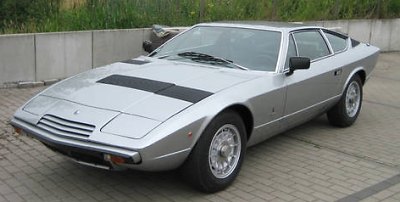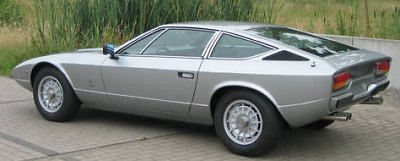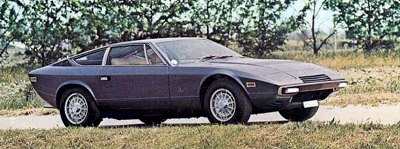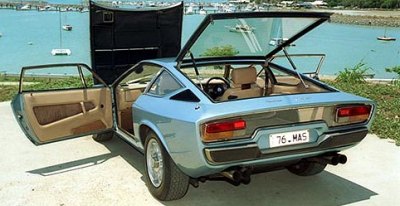 Maserati's brief stint in
supercar business ran from 1967, when Ghibli was introduced, to 1982,
when Khamsin went out of production. Following that was 20 years of
dark period that I would call "De Tomaso-era". Therefore Khamsin was
usually referred to "the last great Maserati".
Khamsin was the direct successor to Ghibli. Although it got an extra pair of rear seats, they were so small that most would use to place belongings rather than any creatures with legs. This effectively ruled it out as a replacement to Indy. In mechanical aspect, the Khamsin was also remarkably close to Ghibli – both were front-engined and rear-drive; both were powered by the same 4930cc quad-cam all-alloy V8; and both shared the same 2550 mm wheelbase. What it advanced over its predecessor was an independent rear suspension by means of double-wishbones (instead of live axle), and a lot of hydraulic systems donated by parent company Citroen.  Of course, its exterior design also differed a lot. While Ghibli was designed by Giorgetto Giugiaro, Khamsin was styled by the equally famous Marcello Gandini of Bertone. This was obvious from its sharp-edge wedge profile as well as its similarity to Lamborghini Urraco. It is a beautiful design, just in different way to Ghibli. Although Khamsin may matched Ferrari Daytona for looks, it failed in performance. The long-serving V8, now rated at 320hp in its final form, was no longer powerful enough for a machine weighing as much as 1680 kg. This mean 0-60 and 0-100 mph took 6.5 and 16 seconds respectively. Having said that, its abundance of low-end torque gave the Khamsin good turn of speed in real-world driving, and worked well with the optional 3-speed automatic. Maserati was still the only Italian supercar maker offering automatic to its high-performance GTs.  The interior was roomier than Bora or most other supercars of its era, though the low roof still presented challenges to tall drivers. The driver seat was height-adjustable hydraulically. The same engine-driven hydraulic pump powered some unusual features of its days: speed-sensitive power steering, assisted brake and clutch. Some of them worked well and some not. The power steering took some getting used to, but once you did, you would find its 2.0 turns lock-to-lock very direct and the light effort enabled you to master it like a big Lotus Elan. On the contrary, the hydraulic assisted braking drew universal criticism because it sensed pedal pressure rather than pedal travel. As a result, it worked like an on-off switch and made a smooth braking impossible.  Brakes aside, the Khamsin was pretty easy to live with. It had plenty of luxury features (standard air-con, electric windows, leather trim and power seats) and good luggage space. Even visibility, which looked poor from the shallow windows and fast rear screen, was surprisingly agreeable once you were on board. In particular, the glass panel at the tail gave extra rear visibility. It was also a unique styling feature of the Khamsin. Nevertheless, commercially the Khamsin did not match half the success of Ghibli. Born at the time of energy crisis and economy recession, the big-capacity supercar did not make much sense. Moreover, having been abandoned by Citroen and received by De Tomaso, Maserati lacked money to make the necessary engine upgrade. This mean Khamsin was left outdated and outclassed by rivals like Aston Martin Vantage, Porsche 911 Turbo and 928.  |